Overview
The three-pronged mission of the University of California includes teaching, research, and public service, none of which can be accomplished without the support of staff who organize and facilitate all that is required to do the work of the university.
University staff members make valuable contributions to supporting the university's overall mission of education, research, public service, and patient care. UC is also the second largest employer in the state of California, making the University a critical player in supporting the state’s economy and workforce.
UC has the following personnel programs:
- Senior Management Group (SMG) or Executives are the senior executive leadership of the university. These include employees such as the President, Chancellors, Vice Presidents, Vice Chancellors, and Campus Counsels (lawyers).
- Managers are a subgroup within the Management and Senior Professionals (MSP) personnel program. They perform managerial and supervisorial duties within academic and administrative departments.
- Senior Professionals (sometimes called Technical/Professional staff) are part of the MSP personnel program. Jobs in this category require a high level of professional experience and carry a significant level of responsibility. Examples include senior administrative analysts and information technology professionals, fundraisers, coaches, and student health physicians.
- Professional and Support Staff (PSS) staff or "Support Staff" perform functions including maintenance, food services, laboratory sciences, student advising and counseling, recreational programs, clerical support, and analysis in areas such as human resources, financial, budget, and accounting. Typical positions include clerical employees, programmer analysts, IT desktop support specialists, administrative analysts, janitors, food service workers, lab technicians, police officers, and others.
The University values a healthy and anti-discriminatory UC workplace, and has a strategic roadmap to ensure that UC is an employer of choice. For policy-covered staff, the 2025-26 budget included a salary program of 3.2 percent over current levels.The University believes that these salary increases are an essential investment for cultivating and retaining its existing workforce, addressing the impact of rising inflation on the purchasing power of UC salaries, and maintaining equity over time relative to salary increases for the university's represented employees. On June 1, 2024, UC increased the minimum hourly wage for designated healthcare employees to $23, with plans to raise it to $24 in June 2025 and $25 in June 2026.
Effective January 1, 2025, UC expanded its paid sick leave policy to include part-time employees and broadened the circumstances under which all employees can utilize this leave. This policy change aims to support work-life balance and ensure that all staff members have access to necessary health-related leave. In February 2024, UC President Michael V. Drake announced the creation of the Systemwide Office of Civil Rights, alongside the issuance of a new Presidential Policy on Anti-Discrimination. This office aims to foster a safer and more welcoming environment for all members of the UC community by addressing and preventing discrimination throughout the system.
Beginning in 2012-13, and at regular intervals thereafter, the Council of University of California Staff Assemblies (CUCSA) and the Office of the President have sponsored a sampling survey of non-represented staff members across the UC System. An impartial, external vendor manages the survey process. Each leadership team in the system is encouraged to review the data for their location with members of their local Staff Assembly, communicate the results to their community, and outline a plan to effect positive change. Survey results are available on the CUCSA staff engagement survey webpage.
In May 2025, James B. Milliken was named the 22nd president of the University of California, succeeding Michael V. Drake, M.D., who had served since 2020. President-designate Milliken brings a wealth of experience in higher education leadership and is set to assume his role on August 1, 2025. In addition, there are new Chancellors on the Berkeley, UCLA, and UC Riverside campuses and another new Chancellor expected for UC Santa Barbara later this year.
As of October 2024, staff FTE was 92,324 on the campuses and 57,848 at the medical centers, making UC the second largest employer in California.
6.1.1 Staff Full-time Equivalent (FTE)

UC employees, full-time equivalent (FTE) dashboard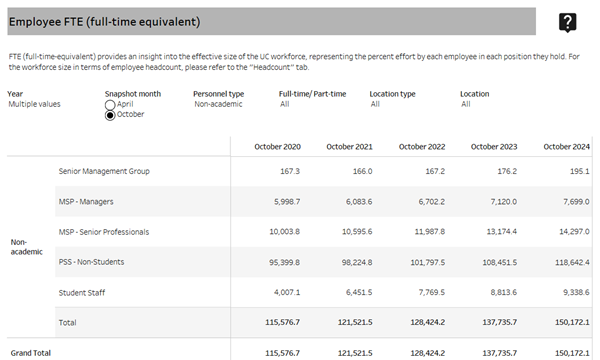
Source: UC Information Center
General campus, non-student staff have seen the greatest and most significant growth amongst senior professionals due to both the introduction of Career Tracks and the professionalization ofUC's workforce towards high-skilled analysis and technical capabilities. Career Tracks is a function-specific, market-aligned job classification system that applies consistent interpretations of which positions are Management and Senior Professional (MSP) and which are Professional and Support Staff (PSS).
UC operates six health systems, including five academic medical centers, as well as schools of medicine, dentistry, nursing, and other health sciences education and research programs. The growth of the University of California Health FTE is also driven by service expansions, such as increases in inpatient days as well as outpatient/emergency visits. During 2023-2024, the University of California Health Enterprise successfully acquired various hospitals. Over 8,000 employees from these hospitals were subsequently transitioned to the UCPath system as UC employees.
6.1 STAFF WORKFORCE
The proportion of underrepresented staff was 36.6% of the workforce in October 2024, up from 30.1% a decade ago. During the same time, the proportion of women increased from 63.2% to 66.3%.
6.1.2a Racial/ethnic diversity of staff

UC workforce diversity dashboard
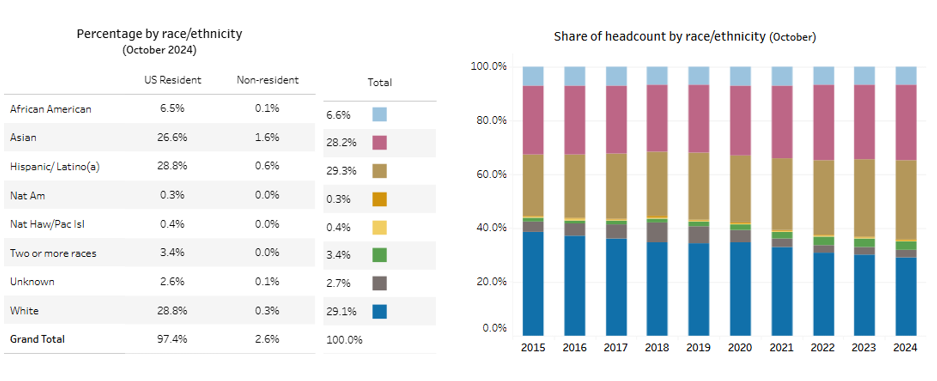
Note: Underrepresented staff include African American, Native American, Native Hawaiian/Pacific Islander, and Hispanic/Latino(a).
6.1.2b Gender diversity of staff

UC workforce diversity dashboard

In 2015-16 through 2019-20, merit-based salary increases averaging 3% for policy-covered staff were implemented. For these employees, there were increases of 4.5% in 2022-23 and 4.6% in 2023-24.
6.2.1 Increases in funding for staff salaries compared to market

University of California Budget for Current Operations 2025-26 Report
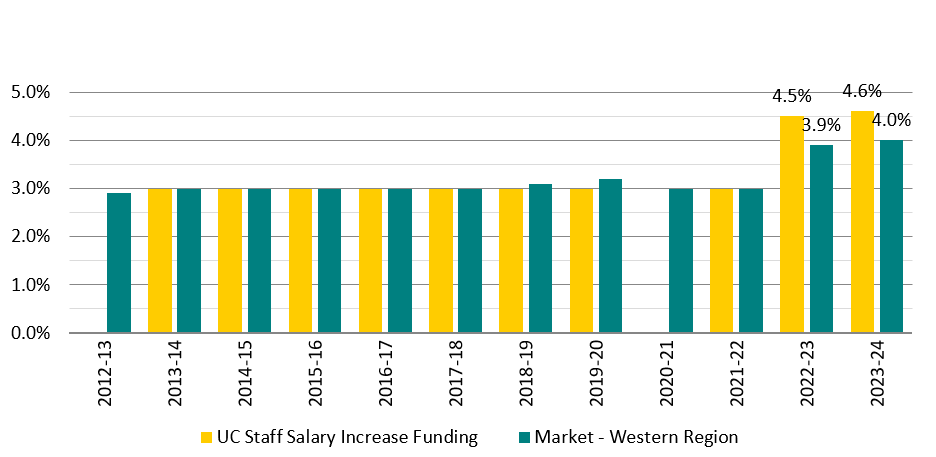
Source:UC Budget for Current Operations 2025-26; sourced from World at Work Annual Salary Budget Survey, which represents data from over 1,000 employers from all sectors in the western United States.
The salary increase for policy-covered staff and academic appointees at all locations recognizes the extraordinary efforts of employees. These above-the-market increases for 2022-23 and 2023-24 were put in place to make up for no salary increases in 2020-21. The University believes that staff these salary increases are an essential investment for cultivating and retaining its existing workforce, addressing the impact of rising inflation on the purchasing power of UC salaries, and maintaining equity over time relative to salary increases for the university's represented employees.
The revised median compensation for UC executives (Chancellors and Presidents) is $921k, which still lags behind the AAU chancellors’ median base compensation at $996k.
6.2.2 Annual base salary rates* for UC executives (Chancellors and Presidents)
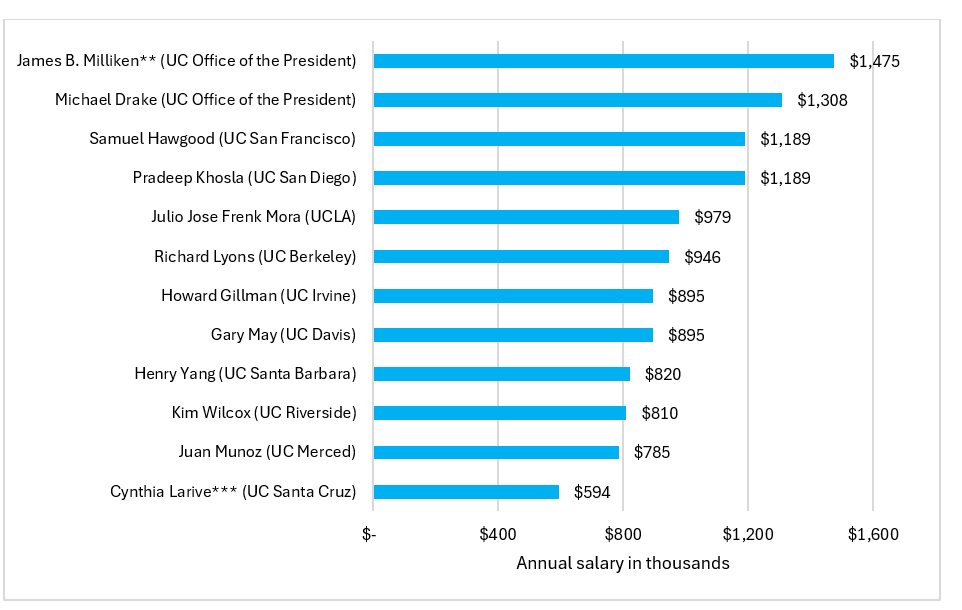
Source: UCPath
*These numbers represent annualized base salary rates as of June 2025.
** As President James B. Milliken will begin on August 1, 2025, this number indicates the future salary rate.
*** The UCSC Chancellor has voluntarily foregone any increases to base salary for FY 24-25.
UC chancellor salaries have historically fallen well below their peers at American Associaton of University (AAU) institutions. In September 2024, the UC Regents approved market-based salary adjustments for seven chancellors (UC Davis, UC Irvine, UC Merced, UC Riverside, UC Santa Barbara, UC Santa Cruz, and UC San Francisco) to bring their base salaries into alignment with the current market, as well as internal and industry peers. With this revision, the base salary rate for chancellors at UC San Diego and UC San Francisco have approached the AAU median base salary rate of $996k. The chancellors who lead UC’s ten campuses, each a top-ranked university in its own right, are renowned scholars and administrative leaders with significant responsibility for ensuring instructional, research, and operational excellence and continually advancing UC’s service to the public. For more information, refer to https://regents.universityofcalifornia.edu/regmeet/sept24/g3.pdf
The separation rate among career staff was 8.5 percent in FY 2024, down from 9.3 percent in the previous fiscal year.
6.3.1a Separation rate for career staff

Staff workforce profile dashboard
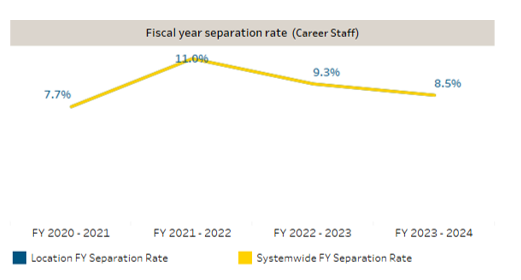
Source: UCPath and CPS
6.3.1b Separation reasons for career staff, FY 2024

Staff workforce profile dashboard
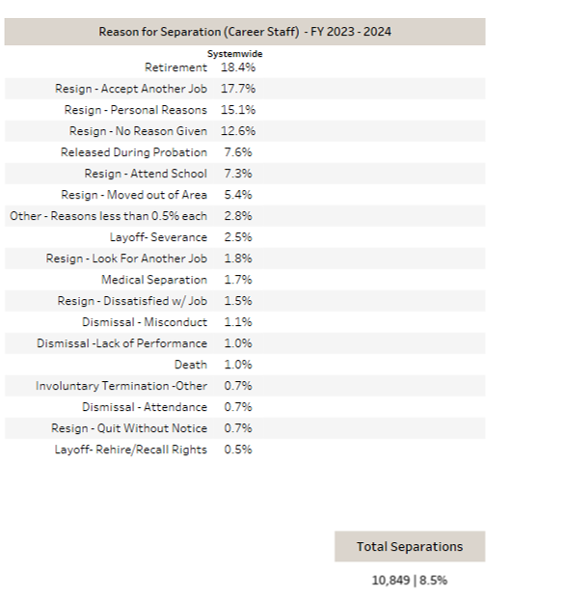
Source: UCPath
Campuses experience a wide range of separation rates among their career staff, which may reflect different mixes of employees, work environments, and local job markets. Retirements and resignations wre the primary separation reason. High turnover is often expensive in terms of lost productivity, lost institutional knowledge, and replacement costs.
![]()






